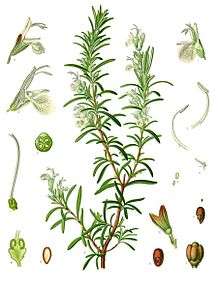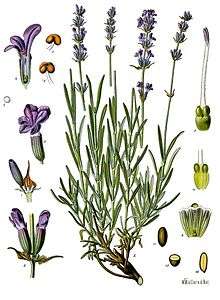Scented water



Scented water, odoriferous water[1] or sweet water,[2][3] is a water with a sweet aromatic smell.[4] It is made of flowers or herbs and is the precursor of the modern day perfume.[5] Scented waters are also used in making other products such as pomanders and body care products.[3]
Ingredients
Some of the flowers and herbs used to make scented water are:
- jasmine [5] Largely used in Indonesia for charmed bath. Also used to cleanse a curse from another shaman or demon.
- lemon [5]
- lavender - from the Latin word lavare, meaning to wash.[6]
- myrtle - one of the original types.[5]
- orange blossoms - one of the best known waters. Orange flower water is also used in various cuisines, to flavor desserts and to mask the taste of hard water.[5]
- roses - distilled are used in cosmetics. Rose water, a byproduct of traditional rose oil production, is prominently used in desserts in Middle Eastern and North Indian cuisine.[7]
- rosemary - believed to refuse to grow in flower gardens of evil people.[8]
Hygiene
In Medieval times a scented water was used for hygiene by a person washing their hands with it before meals, since many meals were forkless.[9][10][11][12] The wealthy of Medieval times had their linen clothes boiled in scented water.[13] Varahamihira (6th century) was using scented water to clean his toothbrushes.[14] Just prior to Marie Antoinette's execution in 1793 one of her servants was able to smuggle her some minimal need requests, one being some scented water for her teeth.[15]
Medical
Hippocrates mentions scented water in his medical practice:
| “ |
Then dipping (BAPTW) into oil of roses or Egyptian oil, apply it through the day, and, as soon as it stings, take it away, and baptize (BAPTIDZO) it, again, into woman’s milk and Egyptian oil, and apply during the night and rinse with sweet scented water and apply tallow. Hippocrates , ii, 710 [16] |
” |
Washing waters
Boccaccio in his Decameron mentions scented washing waters:
| “ |
Without permitting anyone else to lay a hand on him, the lady herself washed Salabaetto all over with soap scented with musk and cloves. She then had herself washed and rubbed down by the slaves. This done, the slaves brought two fine and very white sheets, so scented with roses that they seemed like roses; the slaves wrapped Salabaetto in one and the lady in the other and then carried them both on their shoulders to the bed... They then took from the basket silver vases of great beauty, some of which were filled with rose water, some with orange water, some with jasmine water, and some with lemon water, which they sprinkled upon them. [17][18] |
” |
Refreshment
It was a custom in the Roman Empire for amphitheatres to be furnished with scented water jet fountain sprays for refreshing the spectators.[19][20][21][22][23] The overhead awning (velarium) shielding the spectators for the Colosseum was saturated with scented water for dripping fragrant water on spectators' heads to keep them cool.[24][25][26][27]
Perfume
Henry Percy, 6th Earl of Northumberland in 1511-12 had various scented waters made for him, which consisted of his usage of over a gallon each week for the year.[28] In the 1571 estate inventory of John Brodocke, an apothecary in Southampton, lists 32 types of scented water that he had as some of the items in his shop.[29] In 17th century Constantinople the Venetians and Genoese had apothecary shops that had merchants of scented water including rose water.[30] Scented waters were still being used into the 19th century of the wealthy nobles in Egypt as a type of perfume. It was an Egyptian custom then to sprinkle guests with rose water or orange-flower water after dinner just before they were to go home.[1]
Even though it is said by scholars that the art of perfumery has it roots in antiquity, the city of Montpellier has self established itself as the birthplace of perfumery. In the 18th century they honored guests of the city with scented water and other 'gifts of fragrance'. There are even perfume manuals that describe Montpellier perfumes as being "a la mode de Montpellier" because of extra ingredients used that enhance their fragrances.[31]
Cooking
Scented rose water is and has been used from time to time for cooking and flavoring foods in various recipes.[32] Rose water is used in Greek cuisine.[7]
Sensual
In Medieval times scented water was used for sensual pleasures.[9]
Religious
In Medieval times scented water was used at baptisms.[33]
Formulas of scented water
Rose water
Mary Hooper in her book called Petals in the Ashes about the Great Fire of 1666 explains that the first step in making "rose water" is to gather together 3 or 4 full roses. These roses should not have been treated in any way with toxic pesticide for obvious reasons. One is to then take a pint of water and put into a saucepan. Then heat the water with the roses in it gently, not allowing it to boil. You are to cook the rose petals until they become transparent. After that happens, allow the cooked rose water to cool. Then drain through a sieve forcing the water to go through the rose petals. The resulting "rose water" is to be refrigerated. The scented water then is used as a cooling agent on the body as well as the face.[34]
Scented bath water
Hooper explains that scented water to bathe in can be made of dried herbs. She explains the idea of making such a scented water is to put 8 tablespoons of dried herbs in a pan of 1 pint of water and simmer for 10 minutes. This water then is to be allowed to cooled. Then it is to be strained to remove all the herb pieces. For the actual bath then a quarter of this scented water is to be put into your bath, highlighted with fresh flower petals on top of the bath water. She explains roses and lovage have a cleansing and deodorising effect. For a refreshing effect she recommends to use rosemary and hyssop. For a relaxing effect to use lime flowers and lavender. For a soothing effect use chamomile and lemon balm.[35]
Footnotes
- 1 2 Baer, p. 43
- ↑ Ponce de León, p. 23
- 1 2 Making Medieval Style Scented Oils & Waters
- ↑ Tietz, p. 116
- 1 2 3 4 5 Scents of the Middle Ages
- ↑ Phaneuf, p. 208
- 1 2 Gladstar, p. 123
- ↑ Books, p. 363
- 1 2 Adamson, p. 161
- ↑ Morgan, p. 156
- ↑ Bober, p. 288
- ↑ Food in the Middle Ages: Eight Things You Probably Didn’t Know
- ↑ Normans / Medieval
- ↑ Donkin, p. 101
- ↑ Feydeau, p. 97
- ↑ History of Baptism
- ↑ Bathing and cleansing of the medieval woman
- ↑ Beauty Aids in Renaissance Italy, page 6
- ↑ Langmead, p. 77
- ↑ Papillon, p. 200
- ↑ Kuniczak, p. 452 High in the rear were sprinklers to cool the spectators and mists of saffon and verbena water.
- ↑ Middleton, p. 86 ...and fountains poured forth jets of perfumed water. Ref: cf. Suet. Nero, 31. footnote 2: It appears to have been the custom, under the Empire, for all theatres and other places of amusement to be provided with perfumed fountains and concealed jets for cooling the air with a fine spray of scented water.
- ↑ Harry Thurston Peck, Harpers Dictionary of Classical Antiquities (1898) Amphitheātrum There were in the amphitheatre concealed tubes, from which scented liquids were scattered over the audience, and which sometimes issued from statues placed in different parts of the building. (Lucan, ix. 808; Spect. 3.)
- ↑ Papillon, p. 200 The awning shielding the amphitheatre was saturated with scented water which dripped, like a fragrant rain, on the spectators' heads.
- ↑ DICTIONARY OF GREEK AND ROMAN ANTIQUITIES, p. 53 There were in the amphitheatres concealed tubes, from which scented liquids were scattered over the audience...
- ↑ Smith Amphitheatrum They were protected from the sun and the rain by an ample canopy, occasionally drawn over their heads. The air was continually refreshed by the playing of fountains, and profusely impregnated by the grateful scent of aromatics.
- ↑ Smith Amphitheatrum but the velarium, or awning, by which the spectators were sheltered from the sun, requires some explanation, which will be found under Velum. The space required for the working of the velarium, and the height necessary for keeping it from bending down by its own weight so low as to obstruct the view from the upper benches, are probably the reasons for the great disproportion between the height of the upper part of the amphitheatre, and the small number of spectators accommodated in that part. The luxurious appliances of fountains of scented water to refresh the spectators, and so forth, are sufficiently described in the passage already quoted from Gibbon (cf. Lucan IX.808).º
- ↑ Woolgar, p. 140
- ↑ Woolgar, p. 271
- ↑ Donkin, p. 32
- ↑ Feydeau, p. 8
- ↑ Lyttelton, p. 109
- ↑ Lyttelton, p. 127
- ↑ Hooper, p. 191
- ↑ Hooper, p. 193
Primary sources
- French, John, Art of Distillation, 1653
- Plat, Hugh, Delightes for Ladies 1594
- Markham, Gervase, English Housewife, 1615
Secondary Sources
- Adamson, Melitta Weiss, Food in medieval times, Greenwood Publishing Group, 2004, ISBN 0-313-32147-7
- Baer, Eva, Metalwork in medieval Islamic art, SUNY Press, 1983, ISBN 0-87395-602-8
- Bober, Phyllis Pray, Art, Culture, and Cuisine: Ancient and Medieval Gastronomy , University of Chicago Press, 2001, ISBN 0-226-06254-6
- Boeser, Knut, The elixirs of Nostradamus: Nostradamus' original recipes for elixirs, scented water, beauty potions, and sweetmeats, Moyer Bell, 1996; ISBN 1-55921-155-5
- Books, Storey, Country Wisdom & Know-How: Everything You Need to Know to Live Off the Land, Black Dog Publishing, 2004, ISBN 1-57912-368-6
- DICTIONARY OF GREEK AND ROMAN ANTIQUITIES, 1886, Original from Harvard University
- Donkin, R. A., Dragon's brain perfume: an historical geography of camphor, BRILL, 1999, ISBN 90-04-10983-8
- de Feydeau, Elisabeth, A scented palace: the secret history of Marie Antoinette's perfumer , I.B. Tauris, 2006, ISBN 1-84511-189-3
- Gladstar, Rosemary, Rosemary Gladstar's Herbal Recipes for Vibrant Health: 175 Teas, Tonics, Oils, Salves, Tinctures, and Other Natural Remedies, Storey Publishing, 2008, ISBN 1-60342-078-9
- Hooper, Mary, Petals in the Ashes, Bloomsbury Publishing, 2004, ISBN 1-58234-720-4
- Kuniczak, W. S., Quo Vadis, Hippocrene Books, 1999, ISBN 0-7818-0763-8
- Lyttelton, Celia, The Scent Trail: How One Woman's Quest for the Perfect Perfume Took Her Around the World, Penguin Group, 2009, ISBN 0-451-22624-0
- Langmead, Donald, Encyclopedia of architectural and engineering feats, ABC-CLIO, 2001, ISBN 1-57607-112-X
- Middleton, John Henry, The remains of ancient Rome, Volume 2, A. and C. Black, 1892
- Morgan, Phillippa, Chaucer and the Legend of Good Women: A Medieval Murder Mystery , Carroll & Graf Publishers, 2005, ISBN 0-7867-1598-7
- The elixirs of Nostradamus: Nostradamus' original recipes for elixirs, scented water, beauty potions, and sweetmeats,
- Papillon, Fernand, Nature and life: Facts and doctrines relating to the constitution of matter, the new dynamics, and the philosophy of nature, D. Appleton and Company, 1875
- Phaneuf, Holly, Herbs Demystified: A Scientist Explains How the Most Common Herbal Remedies Really Work, Marlowe & Company, 2005, ISBN 1-56924-408-1
- Ponce de León, Néstor, Technological dictionary, Colonial Pub. Co., 1920
- Smith, William, A Dictionary of Greek and Roman Antiquities, John Murray, London, 1875.
- Tietz, Joan Ann, A thousand years of sweet: a semantic and cultural study, Peter Lang, 2001, ISBN 0-8204-5383-8
- Woolgar, C. M., The senses in late medieval England, Yale University Press, 2006, ISBN 0-300-11871-6